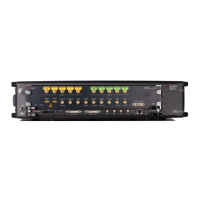The amplitude multiplier allows to scale the amplitude of the DAC output signal (see
Figure 4-1).
The chain of interpolation filters and the IQ modulator could increase the signal value,
which then exceeds the valid DAC range. This leads to a clipping of samples. This effect
depends on the input data and therefore cannot be handled automatically.
The instrument is able to detect clipping and signals it to the user by the status register
or a dialog box in the soft front panel. Clipping could be prevented by using scale factor
values of 1.0 or smaller. This scale factor value reduces the output amplitude relative to
the direct mode to approx. 37.6%.
It is possible to increase the scale factor up to 2.828, but depending on the input IQ
sample sequence this can result in signal clipping. The value can be separated into two
multiplication factors:
Factor 2.0 is related to the interpolation filters and is dependent from the input
sample sequence.
Factor 1.414 is related to the IQ modulators. The maximum I value (1.0) and the
maximum Q value (1.0) causes a resulting vector with a length of sqrt (2)≈1.414.
So whenever the user can guarantee that the sum of I and Q doesn’t exceed the unit
circle, it is safe to set the scale value to 1.414 and increase the overall amplitude (see
section 8.24.4).
There are 3 possibilities to scale the DAC output signal:

